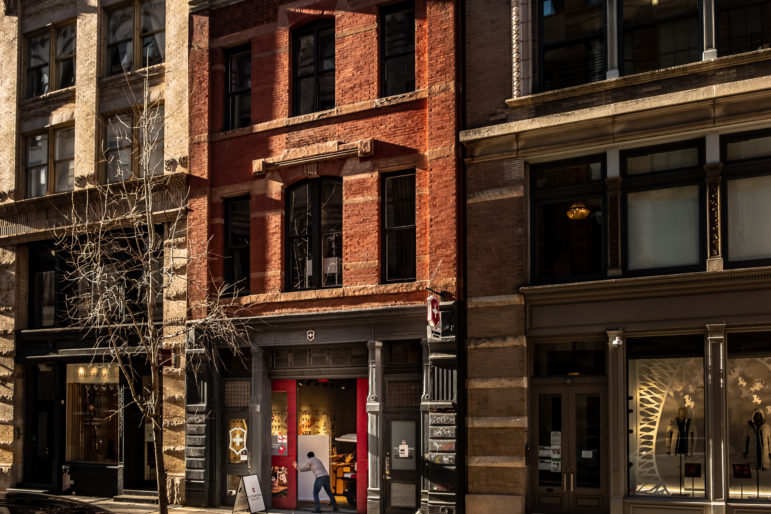While developers will seriously benefit from a chance to build market-rate apartments in one of the city’s most coveted zip codes, the de Blasio administration says the new construction will also create about 900 apartments deemed affordable under the mayor’s signature Mandatory Inclusionary Housing (MIH) policy.

Adi Talwar
Buildings and apartments in SoHo.The City Council approved a plan Wednesday that will introduce thousands of new apartments to SoHo, an iconic Manhattan neighborhood with wonky land use arrangements and pricey homes out of reach to the vast majority of renters. Mayor Bill de Blasio and the plan’s supporters say the rezoning will change that, at least for a few hundred New Yorkers.
City officials estimate that adjustments to the size and type of buildings allowed in the 56-block rezoning area will fuel the creation of 3,000 new residential units. And while developers will seriously benefit from a chance to build market-rate apartments in one of the city’s most coveted zip codes, the de Blasio administration says the new construction will also create about 900 apartments deemed affordable under the mayor’s signature Mandatory Inclusionary Housing (MIH) policy.
Under MIH, developers constructing residential buildings in a rezoned area are forced to reserve a certain amount of the units for New Yorkers earning a percentage of area median income (AMI)—a.k.a. low- and middle-income renters.
So how much will those new affordable apartments actually cost? That depends, but at least some will cost well below $1,000 per month.
The math
In the simplest terms, the rents are set so that families and individuals who qualify for an affordable unit in an MIH building end up paying no more than a third of their income on housing and utilities, the city’s Department of Housing and Preservation Development (HPD) says.
But breaking down the actual monthly cost of each new apartment gets complicated because the “affordable” rents mandated by MIH vary based on apartment size, family size, specific income and the average price of other apartments in the building.
The land use plan approved by the Council for SoHo mandates developers adhere to “Option 1” of the city’s MIH rules, which states that 25 percent of new units remain affordable to individuals and families earning an average of 60 percent of AMI (just over $50,000 for an individual or $64,440 for a family of three). AMI is a federal formula used as a guideline to determine appropriate housing costs. In New York City, the AMI for a three-person family is $107,400—way more than the actual average family income in the five boroughs (the median household income in 2019 was $63,998, according to Census data).
The MIH Option 1 rules allow for a range of income bands, so long as the final average equals 60 percent of AMI. Getting to that number is a matter of math.
Consider the example of a newly constructed 200-unit building in the rezoned area: Based on MIH rules, 25 percent of the total floor area must be reserved for affordable housing, which would roughly equal 50 of the 200 apartments. To reach the 60 percent AMI average, a developer may reserve 20 units for tenants earning 80 percent of AMI (with rents around $2,000 for a two-bedroom), another 10 for tenants making 60 percent AMI (about $1,500 for a two-bedroom) and 20 for tenants at 40 percent (with rent for a two-bedroom around $950).
At the same time, at least 10 percent of the housing must be affordable for families or individuals earning at or below 40 percent of AMI ($33,440 for an individual or $42,960 for a family of three). “Affordable” means the units are priced at roughly the equivalent of 30 percent of household income under the city’s Department of Housing Preservation and Development (HPD) guidelines.
So a family of three making just under $43,000 could afford a unit priced around $900 per month based on HPD’s calculations, though developers have some flexibility to price the units slightly higher. The apartment could theoretically be a one-bedroom or a two-bedroom.
At a February presentation by the Department of City Planning and HPD, city officials said MIH units in SoHo could range from $732 for a studio for a person or couple earning about $43,000 per year to just under $2,000 for a two-bedroom for a family of four earning $95,440 (80 percent of AMI).
While those sums may still be unattainable to many low-income New Yorkers, “it’ll still be substantially lower than new market rates in SoHo,” said Sam Stein, a policy analyst at the Community Service Society of New York (a City Limits funder).
The median rent in Manhattan’s Community District 2, which includes the rezoning area, was $2,830 per month for a two- or three-bedroom apartment in 2019, according to an annual analysis by New York University’s Furman Center. The median rent for a one-bedroom or studio was $2,640. Both amounts made CD2 the most expensive rental market among New York City’s 59 community districts, the Furman Center found. The median rent for one-bedrooms currently on the market is $5,050 per month, according to the real estate website Zumper.
During their February presentation, city officials cited sample market rents of $12,758 for a three-bedroom, $8,067 for a two-bedroom and $2,291 for a studio based on StreetEasy listings. Those figures also illustrate the point that de Blasio and rezoning supporters have made to justify the plan to increase density in SoHo and NoHo.
“SoHo and NoHo are two of the most iconic neighborhoods in the country for a reason—and now, we are one step closer to them finally reflecting all the diversity that makes our city great,” de Blasio said in a statement following the vote.
A review of MIH units in an upcoming 10-story complex in Far Rockaway—rezoned in 2017— provides some additional context when it comes to potential monthly rents.
The new building on Beach 21st Street will have 200 units reserved for renters earning at or below 100 percent of AMI, with incomes varying from $20,400 for an individual to $148,000 for a family of seven.
The city’s affordable housing lottery, known as Housing Connect, specifically advertises six studios for individuals or two-person families earning at or below 40 percent of AMI, with rent set at $522. Housing Connect allows two-person families with an annual income between $20,400 to $38,200 to apply and qualify for those studios.
There are also 17 one-bedroom apartments priced at $665 per month and reserved for individuals and families of two or three who make up to 40 percent of AMI. To qualify for those units, individuals must make between $25,646 to $33,440, families of two must make between $25,646 to $38,200 per year and families of three must make $25,646 to $42,960.
Another 15 two-bedroom apartments will go to families making up to 40 percent of AMI, allowing seven-person families to qualify if they make $36,446 to $59,200. The units are priced at $809 per month.
There are another 22 units—from studios to three-bedrooms—for individuals and families earning up to 60 percent of AMI. To qualify for one of the six two-bedrooms, four-person families can make between $47,966 and $71,580 per year. Those rents are set at $1,290 per month.

John McCarten/NYC Council Media Unit
Councilmember Margaret Chin, whose district includes the SoHo rezoning area, voted in favor of the project.Skepticism persists
Yet, those rents will remain out of reach for many existing residents of Far Rockaway. That has been one of the major criticisms of de Blasio’s past rezonings, which targeted lower-income communities of color, like East New York and a long stretch of Jerome Avenue in the Bronx.
A July study by the Association for Neighborhood & Housing Development (ANHD) found that de Blasio’s MIH policy has contributed to gentrification in lower-income neighborhoods of color because the “affordable” income bands outpace the annual earnings of many current residents, pricing them out of new developments and threatening to raise rents in the surrounding community.
That won’t be the case in SoHo, said ANHD Land Use Policy Coordinator Christopher Walters.
“A rent for a 60-percent-AMI unit is going to be the same in SoHo as it is in Far Rockaway or East New York,” Walters said. “The huge difference is the rent at that level makes the neighborhood [SoHo] accessible to many families who wouldn’t otherwise be able to afford it.”
Nevertheless, the failures and unfulfilled commitments of past rezonings have contributed to opposition against the SoHo plan. So has the fact that the majority of new units will be market-rate apartments—a windfall for developers.
“In spite of all the smoke and mirrors, let’s be clear: this plan is a giant giveaway to real estate interests, with the promise that a tiny percentage of that enormous gift will be returned to the public in the form of new affordable housing,” said Village Preservation Executive Director Andrew Berman following the Council vote Wednesday. “The reality is, in by far the majority of cases, it won’t.”
Berman has led opposition to the plan and commissioned a study on the city’s failures to accurately predict the amount of new affordable housing created on the sites of new residential construction.
He has said he is particularly skeptical of the city’s estimates of how many affordable units the plan will create because two of its big supporters, de Blasio and local Councilmember Margaret Chin, are heading out the door in less than three weeks.
“It makes no sense for this to get done in the final days of an administration and of the term of a councilmember who are going to be gone the second it’s passed and have no responsibility for its results,” Berman told Politico.
For her part, Chin said the rezoning represents a key part of her legacy and she trusts the city’s ability to reach the affordable housing targets.
“I’m retiring and I’m going to live a relaxing life,” she said. “But I will be monitoring all the commitments I worked on.”










2 thoughts on “Newly-Approved SoHo Rezoning Promises Affordable Homes. How Much Will they Really Cost?”
No comments
““I’m retiring and I’m going to live a relaxing life,” she said. “But I will be monitoring all the commitments I worked on.””
More lies from the pathological liar, Margaret Chin.
Continue to monitor?
Chin only showed up to one of the three dozen public meetings in 2019 about this upzoning. Such contempt of her constituents,
Worse, she did not even have the courage or concern to attend a Zoom meeting of the community board this month dealing with draconian and spiteful fines that she introduced, starting at $40,000, to be levied on her constituents who were not “certified artists” via a new bill that she inexplicably introduced last month, that had no co-sponsors or even had one sentence of a council debate before it was passed
This bill is clearly a punishment for SoHo residents who repeatedly and overwhelmingly rejected her at the polls on several occasions,
That only thing Chin will be moitoring is her financial portfolio, enlarged by the contributions from her real-estate developer cronies.